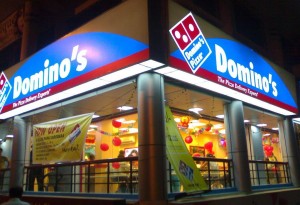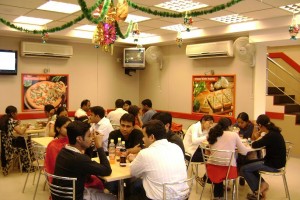Apply only if you are a big risk taker
 Jubilant Foodworks Limited (JFL) is tapping the capital markets to raise between Rs 306 crs to Rs 328 crs. The issue opens on Monday the 18th of January and closes on Wednesday the 20th of January.
Jubilant Foodworks Limited (JFL) is tapping the capital markets to raise between Rs 306 crs to Rs 328 crs. The issue opens on Monday the 18th of January and closes on Wednesday the 20th of January.
| Price Band | Rs. 135 to Rs.145 per Equity Share |
| Issue Size | 306.05 crs to 328.72 crs |
| Market Capitalisation post issue | 858.89 crs to 922.52 crs |
| Fresh issue by the Company | 40,00,000 Equity Shares |
| Offer for sale by existing shareholders | 1,86,70,447 Equity Shares |
| Total Issue Size | 2,26,70,447 Equity Shares |
| Reservation for Employees | 22,67,044 Equity Shares |
| Net Offer to Public | 2,04,03,403 Equity Shares |
| QIBs | 1,02,01701 Equity Shares |
| Non-Institutional Buyers | 30,60,510 Equity Shares |
| Retail Individual Bidders | 71,41,191 Equity Shares |
| Equity shares outstanding after the Issue | 6,36,21,741 Equity Shares |
| Issue opens on | Monday, January 18, 2010 |
| Issue closes on | Wednesday, January 20, 2010 |
| Book Running Lead Manager | Kotak investment Banking |
| IPO Grading | 3/5 by Fitch |
 |
 |
Business
JFL is the exclusive Master Franchisee for Domino’s in India, Nepal, Bangladesh and Sri Lanka. Domino’s began operations in the USA in 1960 and currently have 8500 pizza stores in 60 countries involving 2000 franchisees. JFL began operations in 1995 and currently have 286 stores as of November 2009, in 59 Indian cities and 5 stores in Sri Lanka through a sub-franchisee. JFL is the market leader in the organised pizza home delivery segment in India with a market share of about 65%.
JFL has introduced new pizzas as well as side dishes to cater to the Indian taste and choice. The company has a pan-India presence in 22 states, 59 cities and 286 stores. The domination is in the metros with 48 stores in Mumbai, 36 in Bengaluru, 35 in Delhi, 18 in Chennai and 12 in Kolkata. There are 149 stores in 5 metros or 52% of the total stores are in these five cities. JFL follows a model where the catchment area of a store is 20,000 households. The company believes that the growth potential in the five metros has yet to be fully tapped.
JFL has a three pronged marketing strategy wherein there are national marketing campaigns on television, print and radio. The second is at the local store level where the aim is to increase customer penetration and the third is CRM or customer relationship management to optimise information from point of sales system.
The punch line of JFL’s success has been its delivery commitment where if the pizza is not delivered at your doorstep within 30 minutes, the pizza is delivered free to the customer. JFL has four regional supply chain centres or commissaries located in Delhi NCR, Mumbai, Bengaluru and Kolkata. This helps in having centralised sourcing, quality of inputs being maintained, optimising input costs and helps in distributing store requirements within 24 hours from any of the central commissaries.
Financials
JFL has been making small profits for the last three years. In 2005 its net worth was eroded but since then has been steadily improving. It had net sales of 138 crs in March 2007, Rs 211 crs in March 2008, Rs 280 crs in March 2009 and Rs 182 crs in the first six months of 2009-2010. At the net level the profits were Rs 5.58 crs in 2007, Rs 7.78 crs in 2008, Rs 6.74 crs in 2009 and Rs 12.1 crs incurrent half year. The company has a carried forward loss of Rs 62 crs as of September 2009 which will help it keep PBT and PAT margins almost similar, other than MAT.
The company has a term loan of Rs 117.7 crs which after repayments now stands at Rs 73.48 crs as of 30th November 2009. A part of the fresh capital proceeds would be used to repay this debt.
Objects of the Issue
The issue would raise Rs 306 crs at the lower price and about Rs 328.7 crs at the upper price band. Of the total issue size of 2.27 cr shares, 1.87 crs or 82.35% is by way of an offer for sale. Effectively this means that the company JFL is going to receive a mere Rs 54 crs at the lower price band and Rs 58 crs at the upper price band. Of the above amount the company will utilise 35 crs towards debt repayment, and the balance amount of between Rs 19 and 23 crs net of issue expenses would be used for general corporate expenses.
The big benefit the company will derive is benefits of listing and this could be leveraged for future acquisitions or setting up new food related business in the country.
The biggest object of this issue is to provide an exit to two private equity investors who have invested from October 1999 to October 2003. These two funds are M/s India Private Equity Fund and M/s Indocean Pizza Holding Limited. The promoters and the promoter group which comprise of Mr Shyam Bhartia, Hari Bhartia and the Jubilant group, own 66.24% of the company pre-IPO which would get diluted to 62.07% post IPO.
All investments in the company in equity have been made at Rs 10 whether it is by the promoters or the private equity investors and there have been no bonus issues of any kind so far.
Comparison
JFL is a ‘QSR’ quick service restaurant and there is no comparable chain in the listed space in India that one can talk about. Some other comparable chains are KFC, Macdonalds, Pizza Hut etc but none of them are listed and none of them are having such a large presence in the country. The best comparison has to be with listed entities in the pizza space abroad. Such chains command a valuation of 12-15 multiples in various countries and a fairly comparable model could be Papa John’s or Domino’s. There are some upcoming Indian chains like Bikanerwala and coffee chains like Cafe Coffee day which are making their presence felt in the fast growing Indian space.
Risks
The market is growing and with rising disposable income, demographics, the ‘DINK’ (double income no kids) factor, spread of urbanisation and growth of India as a whole are extremely favourable factors for such companies or food chains. It is said that of the Rs 58000 crs food market less than 2% is the current market share of pizza and pasta companies. The opportunity in this industry is therefore huge. The shift in market likes and choices is a big risk. Local competition is always a threat for national chains and the cost of creating awareness at the national level adds to the cost of the pizza.
Secondly with money being raised not to be used for expansion, future debt could again raise costs and therefore hurt the bottom line. Inflation is a big factor and with cost pressure there could be a fall in sales if prices are pushed up and if not a fall in revenue. One should remember that the pizza market is hardly penetrated and the local ‘Udipi’ guy in Mumbai offers a pizza look alike at less than one third the price. Every city in Mumbai has a local eatery who offers dine in experience and also offers Pizza while a JFL offers dine in but with limited space and very little alternates.
Valuations
JFL at the lower price band is valuing the company at a market capitalisation of Rs 859 crs to Rs 922 crs. If one were to do a quick calculation of dividing it by the number of stores it comes to a staggering 3 crs per store at the lower price band and Rs 3.22 crs at the higher price band.
If one were to do it in terms of sales the sales as of March 2009 were at Rs 280.6 crs or just under Rs 1 cr per store. If one were to base it on September 2009 sales annualised, the sales per store would rise to Rs 1.26 crs per store. In this case we would be talking of a valuation of 2.35 times sales at the lower end and 2.53 times sales at the higher end of the price band.
If profits and EPS was the way to value the same then based on March 2009 numbers on the basis of post issue capital of 6.36 crs, the EPS would be Rs 1.06. The PE at the lower price band would be 127 times while at the upper end it would be 137 times. If one were to take the September 2009 profit and annualise the same the EPS would be 3.80 and the PE would be Rs 35.5 times at the lower end and 38.15 times at the upper end respectively. One must also note that though the company has tax break it needs to provide MAT and the same would be provided at the end of the year.
Even if one were to discount the growth potential and the India Growth story, valuations on any matrix are stretched and leave nothing for the investor to look forward to. The mere fact that the last three listings in the first week of January in the form of JSW Energy, Godrej Properties and DB Corp have done well is no justification for such pricing.
Conclusion
The name of JFL was recently changed from its earlier name of Domino’s Pizza India Limited. This change in name will allow the company to explore the possibility of bringing other international food chains to India or pursuing other related food activity in India. This name change allows this possibility, and having an experience of over a decade in India, and currently running almost 300 stores this becomes a great advantage. JFL is a niche player and would allow a proxy play on the fast growing India story. Currently there is optimism in the Indian markets and looking at the huge response that was generated in the last IPO of Infinite computer Systems, this issue may also do well. The over subscription in the HNI category plays an important part in the grey market premium and that could provide retail investors with a listing gain.
I believe there is a very large pipeline of IPO’s in the offering and one must pick and choose where one needs to apply for the long term. This issue has brand recall simply because it is a national food chain and has advertisements on television. The product it sells is in the higher category, the issue is aggressively priced and there are high risks involved. Apply only if you have an appetite for high risk and if listing gains are available one must exit to relook the company later on.



Dear Arun, There are two schools of thought on this JFL IPO. Some say that investors should stay away from this issue as valuations are not attractive and others who say it is a first of its kind food services company and one should invest.And you are also of the view that JFL is for those having a High Risk appetite.But in case they do bring in other International Chains into India,then if they are successful then they could mint money, but in case the products are not well accepted by Indian Public then one can incur huge expenses/losses.So though Domino’s Pizza and Mc Donalds business Models have worked well but it is not necessary to assume that other Franchises would do well.Look at the Fire Sales in Top Brand Foreign Clothes Franchises all around India.These were assumed to cater to the high heeled and should have been very profitable.So is it possible that Merchant Bankers and Promoters are not hearing your voice of conscience??? And they may be they have erring once again by not hearing to Arun Kejriwal and pricing the issue in such a manner that there may be nothing left on the table. It is definitely very un-fair to the Investing Public specially now that they are flocking back to IPO Investing.